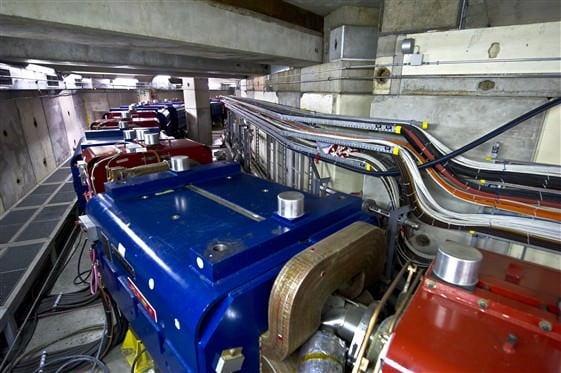[/caption] CERN announced that on March 30 they will attempt to circulate beams in the Large Hadron Collider at 3.5 TeV, the highest energy yet achieved in a particle accelerator. A live webcast will be shown of the event, and will include live footage from the control rooms for the LHC accelerator and all four LHC experiment, as well as a press conference after the first collisions are announced.
"With two beams at 3.5 TeV, we're on the verge of launching the LHC physics program," said CERN's Director for Accelerators and Technology, Steve Myers. "But we've still got a lot of work to do before collisions. Just lining the beams up is a challenge in itself: it's a bit like firing needles across the Atlantic and getting them to collide half way."
The webcast will be available at a link to be announced, but the tentative schedule of events (subject to change) and more information can be found at this link.
Webcasts will also be available from the control rooms of the four LHC experiments: ALICE, ATLAS, CMS and LHCb. The webcasts will be primarily in English.
Between now and 30 March, the LHC team will be working with 3.5 TeV beams to commission the beam control systems and the systems that protect the particle detectors from stray particles. All these systems must be fully commissioned before collisions can begin.
"The LHC is not a turnkey machine," said CERN Director General Rolf Heuer."The machine is working well, but we're still very much in a commissioning phase and we have to recognize that the first attempt to collide is precisely that. It may take hours or even days to get collisions."
The last time CERN switched on a major new research machine, the Large Electron Positron collider, LEP, in 1989 it took three days from the first attempt to collide to the first recorded collisions.
The current Large Hadron Collider run began on 20 November 2009, with the first circulating beam at 0.45 TeV. Milestones were quick to follow, with twin circulating beams established by 23 November and a world record beam energy of 1.18 TeV being set on 30 November. By the time the LHC switched off for 2009 on 16 December, another record had been set with collisions recorded at 2.36 TeV and significant quantities of data recorded. Over the 2009 part of the run, each of the LHC's four major experiments, ALICE, ATLAS, CMS and LHCb recorded over a million particle collisions, which were distributed smoothly for analysis around the world on the LHC computing grid. The first physics papers were soon to follow. After a short technical stop, beams were again circulating on 28 February 2010, and the first acceleration to 3.5 TeV was on 19 March.
Once 7 TeV collisions have been established, the plan is to run continuously for a period of 18-24 months, with a short technical stop at the end of 2010. This will bring enough data across all the potential discovery areas to firmly establish the LHC as the world's foremost facility for high-energy particle physics.
Source: CERN
 Universe Today
Universe Today
